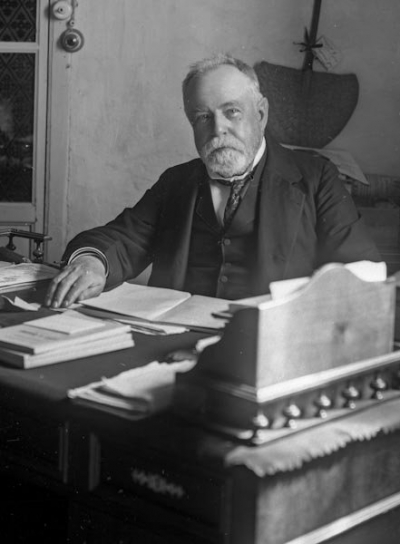The Battle of Santiago de Cuba was a decisive naval engagement that occurred on July 3, 1898 between an American fleet, led by William T. Sampson and Winfield Scott Schley, against a Spanish fleet led by Pascual Cervera y Topete, which occurred during the SpanishAmerican War. The significantly more powerful US Navy squadron, consisting of four battleships and two armored cruisers, decisively defeated an outgunned and outdated squadron of the Royal Spanish Navy, which consisted of four armored cruisers and two destroyers. All the Spanish ships were sunk, but no American ship was lost. The crushing loss sealed American victory in the Cuban theater of the war ensuring the independence of Cuba from Spanish rule.
Tensions between Spain and the United States worsened over the Spanish conduct during their efforts to quell the Cuban War of Independence, with many Americans being agitated by largely exaggerated reports of Spanish atrocities against the Cubans. In January 1898, fearing the fate of American interests in Cuba from the war, the cruiser USS Maine was dispatched to protect them. Less than a month later, the cruiser exploded while lying at anchor in Havana harbor, killing 261 sailors onboard and inflaming American opinion with Spain being portrayed as the culprit in the American media regardless of the actual source of the explosion. Two months later, war was declared.
The Americans realized that defeating a significant Spanish squadron then stationed in Cuba was vital to ensuring victory in the war. A squadron consisting of six warships were dispatched to ensure success, commanded by both Sampson and Schley, each admiral having his own approach to naval warfare. On July 3, the Spanish squadron steamed out of the harbor to engage with the Americans. The Spanish, being totally unprepared and outgunned, made a desperate attempt to reach the open sea with the American battleships and cruisers in hot pursuit. Superior naval gunnery and seamanship prevailed, and the entire Spanish fleet was sunk with minimal casualties for the Americans, who suffered only two men killed or wounded.
The Americans pulled a total of 1889 Spanish sailors from the water, among them Cervera. The captured Spaniards were treated with respect and care by the Americans, and Cervera gained respect from the American officers for his dignified conduct during and after the battle. Although the battle ensured the American campaign in Cuba would end in a success, tensions soon arose between Sampson and Schley, with various parties in the US Navy and the American public debating over which admiral had made the greatest contribution to victory, and the dispute reached the desk of Theodore Roosevelt. The battle remains one of the most significant naval battles in US maritime history.
Admiral Pascual Cervera y Topete (18 February 1839, Medina-Sidonia, Cádiz, Spain – 3 April 1909, Puerto Real, Cádiz, Spain) was a prominent Spanish naval officer with the rank of Almirante (admiral) who served in a number of high positions within the Spanish Navy and had fought in several wars during the 19th century. Having served in Morocco, the Philippines, and Cuba, he went on to be Spain's naval minister, chief of naval staff, naval attaché in London, the captain of several warships, and most notably, commander of the Cuba Squadron during the Spanish–American War. Although he believed that the Spanish Navy was suffering from multiple problems and that there was no chance for victory over the United States Navy, Cervera took command of the squadron and fought in a last stand during the Battle of Santiago de Cuba.

1898Jul, 3
A Spanish squadron, led by Pascual Cervera y Topete, is defeated by an American squadron under William T. Sampson in the Battle of Santiago de Cuba.
Choose Another Date
Events on 1898
- 20Apr
Spanish-American War
President William McKinley signed a joint resolution to Congress for declaration of War against Spain, beginning the Spanish-American War. - 10Jun
United States Marine Corps
Spanish-American War: U.S. Marines land on the island of Cuba. - 3Jul
Battle of Santiago de Cuba
A Spanish squadron, led by Pascual Cervera y Topete, is defeated by an American squadron under William T. Sampson in the Battle of Santiago de Cuba. - 23Aug
Heroic Age of Antarctic Exploration
The Southern Cross Expedition, the first British venture of the Heroic Age of Antarctic Exploration, departs from London. - 13Sep
Photographic film
Hannibal Goodwin patents celluloid photographic film.

 English
English  español
español  français
français  português
português  русский
русский  العربية
العربية  简体中文
简体中文 